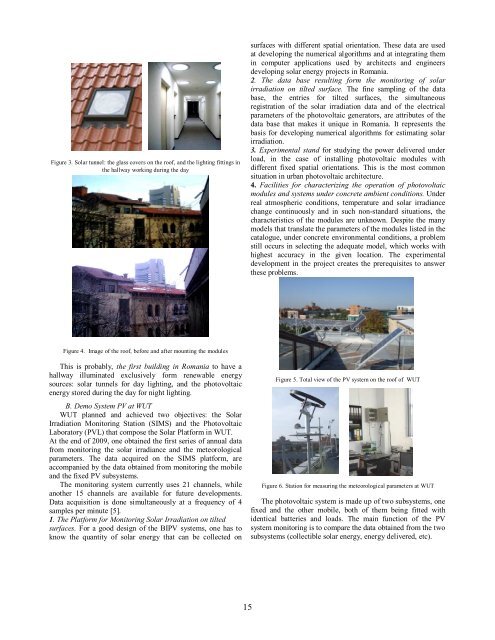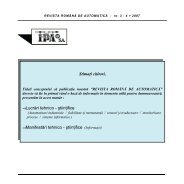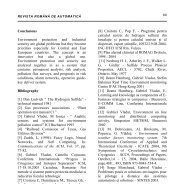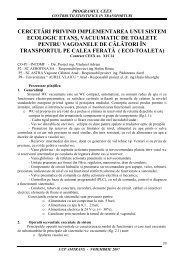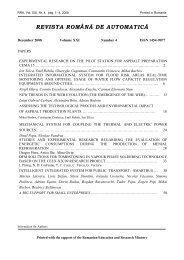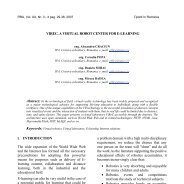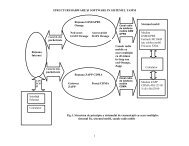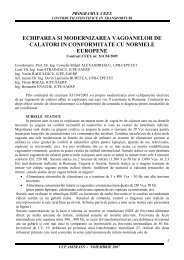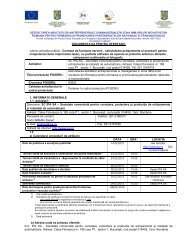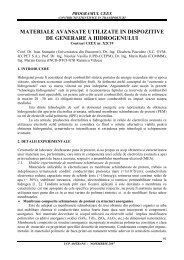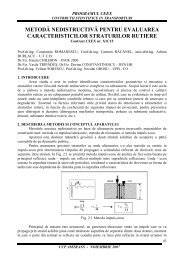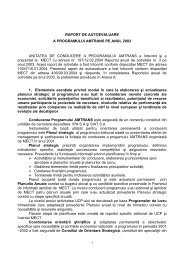0_ CUPRINS - IPA SA
0_ CUPRINS - IPA SA
0_ CUPRINS - IPA SA
Create successful ePaper yourself
Turn your PDF publications into a flip-book with our unique Google optimized e-Paper software.
Figure 3. Solar tunnel: the glass covers on the roof, and the lighting fittings in<br />
the hallway working during the day<br />
surfaces with different spatial orientation. These data are used<br />
at developing the numerical algorithms and at integrating them<br />
in computer applications used by architects and engineers<br />
developing solar energy projects in Romania.<br />
2. The data base resulting form the monitoring of solar<br />
irradiation on tilted surface. The fine sampling of the data<br />
base, the entries for tilted surfaces, the simultaneous<br />
registration of the solar irradiation data and of the electrical<br />
parameters of the photovoltaic generators, are attributes of the<br />
data base that makes it unique in Romania. It represents the<br />
basis for developing numerical algorithms for estimating solar<br />
irradiation.<br />
3. Experimental stand for studying the power delivered under<br />
load, in the case of installing photovoltaic modules with<br />
different fixed spatial orientations. This is the most common<br />
situation in urban photovoltaic architecture.<br />
4. Facilities for characterizing the operation of photovoltaic<br />
modules and systems under concrete ambient conditions. Under<br />
real atmospheric conditions, temperature and solar irradiance<br />
change continuously and in such non-standard situations, the<br />
characteristics of the modules are unknown. Despite the many<br />
models that translate the parameters of the modules listed in the<br />
catalogue, under concrete environmental conditions, a problem<br />
still occurs in selecting the adequate model, which works with<br />
highest accuracy in the given location. The experimental<br />
development in the project creates the prerequisites to answer<br />
these problems.<br />
Figure 4. Image of the roof, before and after mounting the modules<br />
This is probably, the first building in Romania to have a<br />
hallway illuminated exclusively form renewable energy<br />
sources: solar tunnels for day lighting, and the photovoltaic<br />
energy stored during the day for night lighting.<br />
B. Demo System PV at WUT<br />
WUT planned and achieved two objectives: the Solar<br />
Irradiation Monitoring Station (SIMS) and the Photovoltaic<br />
Laboratory (PVL) that compose the Solar Platform in WUT.<br />
At the end of 2009, one obtained the first series of annual data<br />
from monitoring the solar irradiance and the meteorological<br />
parameters. The data acquired on the SIMS platform, are<br />
accompanied by the data obtained from monitoring the mobile<br />
and the fixed PV subsystems.<br />
The monitoring system currently uses 21 channels, while<br />
another 15 channels are available for future developments.<br />
Data acquisition is done simultaneously at a frequency of 4<br />
samples per minute [5].<br />
1. The Platform for Monitoring Solar Irradiation on tilted<br />
surfaces. For a good design of the BIPV systems, one has to<br />
know the quantity of solar energy that can be collected on<br />
Figure 5. Total view of the PV system on the roof of WUT<br />
Figure 6. Station for measuring the meteorological parameters at WUT<br />
The photovoltaic system is made up of two subsystems, one<br />
fixed and the other mobile, both of them being fitted with<br />
identical batteries and loads. The main function of the PV<br />
system monitoring is to compare the data obtained from the two<br />
subsystems (collectible solar energy, energy delivered, etc).<br />
15


